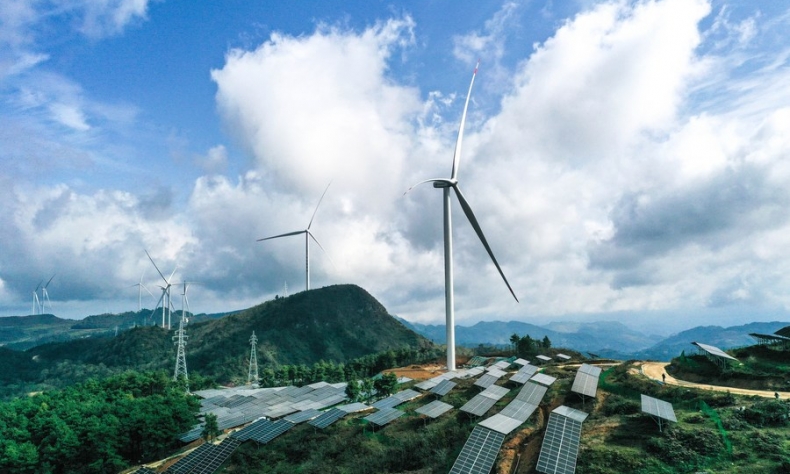The Power of Transformation: China’s Role in the Global Green Energy Era

China’s strategy is not merely a response to environmental imperatives but a deliberate effort to harmonize development with nature.
The global energy landscape is undergoing a profound and massive transformation. Nations are recalibrating their energy strategies to prioritize clean, low-carbon solutions. Amidst this backdrop, China has emerged as a pivotal player, charting a bold course toward sustainability.
China’s State Council Information Office released a landmark white paper titled China’s Energy Transition on August 29. This document chronicles the nation’s remarkable strides in energy reform over the past decade, underscoring its commitment to a greener future. This white paper follows closely on the heels of guidelines issued by China’s central government, which lay out a comprehensive blueprint for a green transition that will permeate every aspect of its economy and society in the coming decade.
China’s strategy is not merely a response to environmental imperatives but a deliberate effort to harmonize development with nature. The guidelines set ambitious targets for achieving significant progress in green production and sustainable lifestyles by 2030, with a long-term vision of establishing a green and low-carbon circular economic development system by 2035. China’s approach to energy and environmental stewardship may well define the trajectory of global sustainability in the years ahead. China’s latest guidelines underscore a transformative vision: a greener, low-carbon future that aligns human progress with environmental stewardship. The focus is clear — by 2030, China aims to make significant strides in green production and lifestyles, setting the stage for a green and low-carbon circular economic development system by 2035. This ambitious roadmap covers key sectors like agriculture, transportation, and energy, with tangible goals such as expanding the energy-saving industry to an impressive 15 trillion yuan ($2.09 trillion) and increasing non-fossil energy consumption to 25 percent of total energy use by 2030.
These targets are more than just numbers; they reflect China’s commitment to harmonizing development with nature. As the world’s most populous nation embarks on this green journey, the implications for global sustainability could be profound, signaling a new era where economic growth and ecological balance are not mutually exclusive but mutually reinforcing. China’s latest guideline sets the stage for a sweeping green transformation, with a sharp focus on revolutionizing public transportation. By 2035, new energy vehicles are expected to lead the automotive market, signaling a profound shift toward clean energy in buses and ships. This is not just about changing how people move but rethinking how society functions in harmony with nature.

The Chinese government’s vision extends beyond transportation. A significant push will be made to foster sustainable lifestyles, urging citizens to conserve resources like food and water. Moreover, the government plans to boost investment in cutting-edge technologies and nurture new talent, ensuring that the intellectual foundation for this green transformation is solid. This comprehensive approach could serve as a global model, showing that environmental responsibility and modern development can walk hand in hand. As the world’s leading energy producer and consumer, China is pivotal to the global energy equation. The transition to clean energy on a global scale is simply unfeasible without China’s active engagement. Acknowledging this, China has undertaken a monumental shift toward green and low-carbon energy, making it a key player in the fight against global energy challenges and environmental threats.
In 2014, President Xi Jinping introduced an energy security strategy centered on “four reforms and one cooperation,” which has since driven significant changes. Over the past decade, China has not only transformed significantly its energy production and consumption but has also achieved historic breakthroughs in renewable energy. This progress is largely attributed to China’s relentless pursuit of technological innovation and the vast growth of its manufacturing sector. As the world navigates the complex journey toward sustainability, China’s leadership in energy transition is essential for crafting a future defined by cleaner, more secure energy systems. China’s ascendancy in renewable energy is not just a product of its internal ambition but also a testament to its openness to global collaboration. With a highly efficient and coordinated manufacturing network, China has built a comprehensive support system that powers every facet of the renewable energy industrial chain.
Years of practical development have endowed China with a robust industrial and supply chain spanning hydroelectric, wind, solar, biomass energy, new energy storage, and electric vehicles. However, China’s progress in this sector also hinges on its strategic embrace of international cooperation. By opening its domestic market to foreign investment, China has created a fertile ground for global energy giants like General Electric, BP, and Siemens to deepen their stakes in the country. Similarly, foreign automakers Tesla, Volkswagen, etc. have made significant investments in electric vehicle production within China. This synergy between domestic innovation and international partnerships has propelled China to the forefront of the global renewable energy revolution as an indispensable player in the world’s quest for a sustainable future.
Imran Khalid is a columnist for Pakistani media outlets, such as The Nation, The News International, and Pakistan Today.
The article reflects the author’s opinions, and not necessarily the views of China Focus.
 Facebook
Facebook
 Twitter
Twitter
 Linkedin
Linkedin
 Google +
Google +





